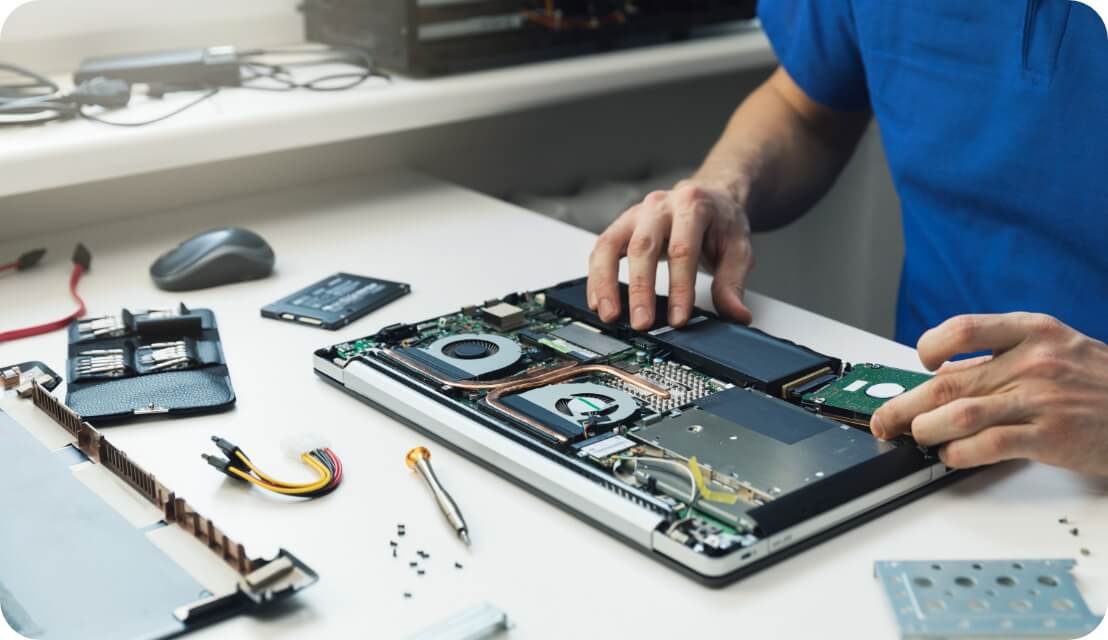Acer Circular Economy Model | ACER ESG
Circular economies differ from the traditional linear economy model in shifting to a cradle-to-cradle circular model that produces no waste. We can accomplish the goals of circular economies through several possible business models, including product sharing, device as a service, repair and refurbishment, remanufacturing, by-products and industrial symbiosis, replacement of raw materials with renewable materials, and resource regeneration and recovery.
Acer employs the concept of circular economies and strives to reduce the impact of our products on the environment throughout their life cycles. Through product design, we enhance product performance, extend product lifespan, or support resource reuse in product manufacturing.
Product Life Cycle Management
During the product design and development phase, we have chosen materials with low impact on the environment, such as post-consumer recycled plastics used in computers and monitors. We have also expanded their use to various product lines in the Vero series, including projectors, computer peripherals, and suitcases. Additionally, we have adopted OBP (Ocean Bound Plastic) in the touchpads of notebook computers and Acer Vero Ocean Series apparels. In terms of chemical management, we have established lists of banned, restricted, and disclosure chemicals to reduce the use of hazardous substances. To improve product energy efficiency, we base our designs on the U.S. ENERGY STAR requirements, while considering product durability and repairability to extend the product lifecycle. For our flagship gaming desktop, the PREDATOR ORION X, we have adopted a fully modular design and a new hybrid architecture to reduce the size while maintaining performance. For displays, we have adopted a mold-sharing approach by using the same front and back frames for specific models, with only new stands developed to minimize the resources and costs associated with new developments.
During the manufacturing phase of our products, We collaborate with suppliers to enhance resource utilization efficiency, reduce carbon emissions, and ensure proper waste management. Since 2019, we have been adhering to the RBA Industry Focus Process Chemical List to monitor the chemicals used in the production process. These chemicals include toluene, benzene, beryllium dust, chlorinated organic solvents, n-hexane, N-Methyl-2-pyrrolidone, and ozone-depleting substances. Monitoring of these chemicals has become a key item in our annual on-site audits. In 2021, we further revised the RBA Industry Focus Process Chemical List and required suppliers to comply with the updated version starting from 2022. The revised list now includes bromopropane, methylene chloride, methanol, tetrachloroethylene, and trichloroethylene. We will continue to monitor industry regulations, assess the possibility of expanding the list of controlled substances to mitigate risks to workers and the environment, and strengthen communication and verification during on-site audits. Acer places great importance on the efficient use and reuse of energy and resources during the manufacturing phase. Through effective supply chain management, we strive to enhance process resource efficiency, minimize energy consumption and greenhouse gas emissions, and implement effective waste management practices.
In the product transportation phase, We work closely with our logistics partners to formulate a sustainable logistics strategy, with a focus on transitioning to low-carbon transportation.
In the post-use phase of our products, We have set a target to achieve a 45% reduction in the average energy consumption of personal computers by 2025, compared to 2016.
In the product disposal phase,We offer various recycling channels to ensure proper recycling and disposal by qualified recycling and processing partners. For more information, please refer to Product Recycling.
We collaborated with our suppliers through the Acer Earthion initiative to minimize environmental impact throughout the design, manufacturing, and transportation stages. Suppliers have installed solar panels and implemented the use of renewable energy to reduce carbon emissions. They have also enhanced their waste management systems, reducing the use of plastic bags in the production line and minimizing the excessive use of security tape when removing containerized pallets, thereby reducing non-recyclable plastic packaging. In addition, the gradual introduction of electric vehicles and biofuel in our product transportation process has also helped us reduce greenhouse gas emissions. For more details, please refer to the Acer Earthion.
Life Cycle Assessment and Product Carbon Footprint
In response to the global low-carbon trend, Acer, as a leading brand, is dedicated to offering consumers more sustainable and eco-friendly products, enhancing product competitiveness, and meeting customer demands. Since 2019, Acer has been producing product life cycle assessment reports and carbon footprint reports for flagship products. Gradually, we have developed them for more notebook computers, desktop computers, and monitors. By analyzing detailed data on product carbon footprints, Acer aims to identify the carbon hotspots of its products and provide feedback to its upstream supply chain. The goal is to reduce carbon footprints and promote carbon reduction actions throughout the supply chain.
In 2023, Acer completed product life cycle assessments or product carbon footprint reports for all commercial notebook computers (including Chromebooks), commercial desktop computers, and representative display products. Additionally, we have obtained a verification statement from a third-party organization for the comprehensive cradle-to-grave carbon footprint calculation of the Aspire Vero AV15-53P notebook computer. The system boundary of the Aspire Vero AV15-53P product carbon footprint includes five stages: raw materials, manufacturing, transportation and distribution, use, and disposal. The carbon footprint calculation result for each AV15-53P notebook computer is 148.53 kgCO2e. Through this product carbon footprint analysis, Acer not only gains a deeper understanding of the carbon emissions hotspots of the product but also assesses the suppliers' ability to provide primary data on product carbon footprints. This information will serve as the basis for proposing measures to reduce product carbon footprints, improve the quality of product carbon footprint data, and establish suppliers' carbon management and reduction capabilities.
Acer’s Circular Economy Model
New business model and Sharing economy
With the new business model of leasing and sharing economy, the services purchasing (rental) is replacing the purchase of hardware equipment such as the DaaS (device as a service) launched by Acer in the pan-European region. DaaS is a complete smart IT solutions with a simplified consumers contract, including hardware, accessories and software solutions for monthly or quarterly payment. Companies using DaaS can rapidly scale their equipment up or down to meet changing demands. Companies can access the latest technology and equipment without having to make large investments. This not only provides the optimal use of resources, but reduces the company's expenditure on IT equipment.


Extend Product Life Cycle
Through product maintenance and refurbishment, the product life cycle is extended as much as possible. For example, HSN, a subsidiary of Acer, provides global support, multi-brand testing, and manufacturer authorized repair and maintenance, from pre-purchase consultation, product function setting, warranty, maintenance, to product recycling at the end of the service life. HSN provides services in every step of the product life cycle, reduce the burden on enterprises and consumers, and improve product performance and reduce environmental impact. Acer’s service center in Taiwan provides quick computer health diagnosis services or computer hardware upgrade promotion during certain periods of time such as the Chinese New Year or the Back to School season where consumers are advised to utilize hardware upgrades to extend product life cycles and reduce electronic waste.
Effective Use of Materials
At the end of the product life cycle, in addition to complying with local regulations for product recycling, Acer has implemented voluntary recycling programs, such as the Acer's Takeback Program in Taiwan. Through 23 service centers and the distribution network across Taiwan, Acer provides regular 3C recycling services for notebooks, mobile phones, tablets, batteries, etc. In addition, Acer actively uses post-consumer recycled plastics and ocean bound plastics in its designs to not only reduce the plastic waste that is difficult to process or may cause environmental pollution when electronic products are discarded,but to promote the development of a circular economy.



